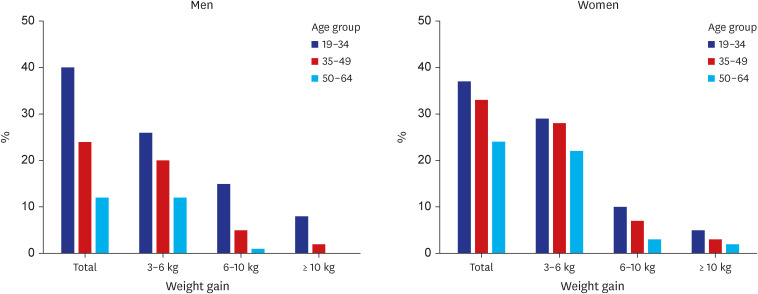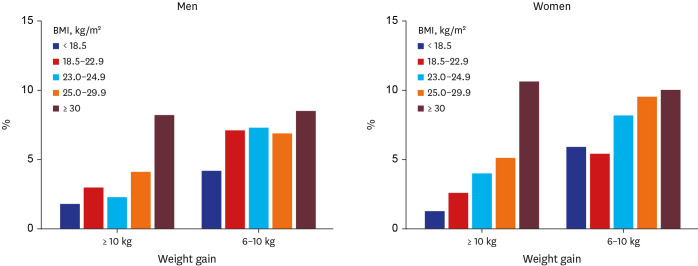J Korean Med Sci.
2023 Mar;38(12):e90. 10.3346/jkms.2023.38.e90.
Weight Gain, Comorbidities, and Its Associated Factors Among Korean Adults
- Affiliations
-
- 1Department of Family Medicine, Uijeongbu Eulji Medical Center, Eulji Unversity, Uijeongbu, Korea
- 2Department of Family Medicine, Wonkwang University Sanbon Hospital, Wonkwang University School of Medicine, Gunpo, Korea
- 3Department of Medicine, University of Ulsan College of Medicine, Ulsan, Korea
- 4Department of Family Medicine, Korea University Guro Hospital, Korea University College of Medicine, Seoul, Korea
- 5Department of Family Medicine, Asan Medical Center, University of Ulsan College of Medicine, Seoul, Korea
- KMID: 2541038
- DOI: http://doi.org/10.3346/jkms.2023.38.e90
Abstract
- Background
Weight gain in adults is associated with an increased risk of obesity-related diseases and high healthcare costs. However, there have been limited studies on weight gain in Asians. This study investigated the prevalence, comorbidities, and associated factors of weight gain in the Korean population.
Methods
This is a cross-sectional study of Korean adults aged 19–64 years who participated in the Korea National Health and Nutritional Examination Survey 2016–2019. We used data from 15,514 adults (subjects 1) to analyze the prevalence of weight gain. Finally, after excluding adults with suspicious debilitating conditions among them, 11,477 adults (subjects 2) were used to analyze comorbidities and associated factors. Weight changes and lifestyle factors were assessed using a self-report questionnaire. We analyzed odds ratios and 95% confidence intervals using multivariable logistic regression analysis to examine factors associated with weight gain.
Results
The overall prevalence of weight gain was 25.7% in men and 31.3% in women and decreased significantly with age in both sexes. Weight gain of ≥ 6 kg was evident in 10.5% of men and 9.8% of women and was more pronounced with a higher baseline body mass index (BMI). Most metabolic comorbidities worsened the greater the weight gain. Young age was the strongest associated factor for weight gain. Other factors associated with weight gain were being unmarried, blue-collar job, lower income, and alcohol consumption in men; being married in women; smoking and skipping breakfast in both sexes.
Conclusion
Weight gain was much more pronounced in younger adults and at a higher baseline BMI in both sexes. Public education and health policies to prevent unnecessary weight gain should be strengthened by considering the associated harmful factors in Korean adults.
Keyword
Figure
Reference
-
1. Poirier P, Alpert MA, Fleisher LA, Thompson PD, Sugerman HJ, Burke LE, et al. Cardiovascular evaluation and management of severely obese patients undergoing surgery: a science advisory from the American Heart Association. Circulation. 2009; 120(1):86–95. PMID: 19528335.2. World Health Organization. Fact sheets: obesity and overweight. Updated 2021. Accessed May 31, 2022. https://www.who.int/news-room/fact-sheets/detail/obesity-and-overweight .3. NCD Risk Factor Collaboration (NCD-RisC). Worldwide trends in body-mass index, underweight, overweight, and obesity from 1975 to 2016: a pooled analysis of 2416 population-based measurement studies in 128·9 million children, adolescents, and adults. Lancet. 2017; 390(10113):2627–2642. PMID: 29029897.4. Korean Statistical Information Service. Prevalence of obesity. Updated 2022. Accessed July 19, 2022. https://www.index.go.kr/unity/potal/main/EachDtlPageDetail.do?idx_cd=2705 .5. Alley DE, Chang VW. Metabolic syndrome and weight gain in adulthood. J Gerontol A Biol Sci Med Sci. 2010; 65(1):111–117. PMID: 19906821.6. Willett WC, Manson JE, Stampfer MJ, Colditz GA, Rosner B, Speizer FE, et al. Weight, weight change, and coronary heart disease in women. Risk within the ‘normal’ weight range. JAMA. 1995; 273(6):461–465. PMID: 7654270.7. Galanis DJ, Harris T, Sharp DS, Petrovitch H. Relative weight, weight change, and risk of coronary heart disease in the Honolulu Heart Program. Am J Epidemiol. 1998; 147(4):379–386. PMID: 9508105.8. Chen C, Ye Y, Zhang Y, Pan XF, Pan A. Weight change across adulthood in relation to all cause and cause specific mortality: prospective cohort study. BMJ. 2019; 367(8218):l5584. PMID: 31619383.9. Elmer PJ, Brown JB, Nichols GA, Oster G. Effects of weight gain on medical care costs. Int J Obes. 2004; 28(11):1365–1373.
Article10. Nichols GA, Bell K, Kimes TM, O’Keeffe-Rosetti M. Medical care costs associated with long-term weight maintenance versus weight gain among patients with type 2 diabetes. Diabetes Care. 2016; 39(11):1981–1986. PMID: 27561921.
Article11. Lake A, Townshend T. Obesogenic environments: exploring the built and food environments. J R Soc Promot Health. 2006; 126(6):262–267. PMID: 17152319.
Article12. Gallagher D. Overweight and obesity BMI cut-offs and their relation to metabolic disorders in Koreans/Asians. Obes Res. 2004; 12(3):440–441. PMID: 15044659.
Article13. Centers for Disease Control and Prevention. Adults obesity maps. Updated 2022. Accessed July 19, 2022. https://www.cdc.gov/obesity/data/prevalence-maps.html .14. Korean Diabetes Association. Diabetes fact sheets 2018. Updated 2018. Accessed July 19, 2022. https://www.diabetes.or.kr/bbs/?code=fact_sheet&mode=view&number=1615&page=1&code=fact_sheet .15. Centers for Disease Control and Prevention. National Diabetes Statistics Report, 2020: Estimates of Diabetes and Its Burden in the United States. Atlanta, GA, USA: US Department of Health and Human Services;2020.16. He W, Li Q, Yang M, Jiao J, Ma X, Zhou Y, et al. Lower BMI cutoffs to define overweight and obesity in China. Obesity (Silver Spring). 2015; 23(3):684–691. PMID: 25645003.
Article17. Korea Centers for Disease Control and Prevention. Ministry of Health and Welfare (KR). 2019 national health statistics. Updated 2020. Accessed June 27, 2022. https://knhanes.kdca.go.kr/knhanes/sub04/sub04_04_01.do .18. World Health Organization Western Pacific Region. The Asia-Pacific perspective: redefining obesity and its treatment. Updated 2000. Accessed July 19, 2022. https://apps.who.int/iris/handle/10665/206936 .19. Korean Society for the Study of Obesity. 2020 quick reference guideline for obesity. Updated 2022. Accessed July 19, 2022. http://general.kosso.or.kr/html/?pmode=BBBS0001300003&page=1&smode=view&seq=1375&searchValue=&searchTitle=strTitle .20. Lee SY, Park HS, Kim DJ, Han JH, Kim SM, Cho GJ, et al. Appropriate waist circumference cutoff points for central obesity in Korean adults. Diabetes Res Clin Pract. 2007; 75(1):72–80. PMID: 16735075.
Article21. Korea Centers for Disease Control and Prevention. KNHANES VII guidelines for conducting investigations, 2016–2018. Updated 2021. Accessed June 27, 2022. https://knhanes.kdca.go.kr/knhanes/sub04/sub04_02_02.do?classType=4 .22. Katsoulis M, Lai AG, Diaz-Ordaz K, Gomes M, Pasea L, Banerjee A, et al. Identifying adults at high-risk for change in weight and BMI in England: a longitudinal, large-scale, population-based cohort study using electronic health records. Lancet Diabetes Endocrinol. 2021; 9(10):681–694. PMID: 34481555.
Article23. Williamson DF, Kahn HS, Remington PL, Anda RF. The 10-year incidence of overweight and major weight gain in US adults. Arch Intern Med. 1990; 150(3):665–672. PMID: 2310286.
Article24. Anderson DA, Shapiro JR, Lundgren JD. The freshman year of college as a critical period for weight gain: an initial evaluation. Eat Behav. 2003; 4(4):363–367. PMID: 15000962.
Article25. Pereira MA, Kartashov AI, Ebbeling CB, Van Horn L, Slattery ML, Jacobs DR Jr, et al. Fast-food habits, weight gain, and insulin resistance (the CARDIA study): 15-year prospective analysis. Lancet. 2005; 365(9453):36–42. PMID: 15639678.
Article26. Hankinson AL, Daviglus ML, Bouchard C, Carnethon M, Lewis CE, Schreiner PJ, et al. Maintaining a high physical activity level over 20 years and weight gain. JAMA. 2010; 304(23):2603–2610. PMID: 21156948.
Article27. Hebden L, Chey T, Allman-Farinelli M. Lifestyle intervention for preventing weight gain in young adults: a systematic review and meta-analysis of RCTs. Obes Rev. 2012; 13(8):692–710. PMID: 22413804.
Article28. Kang SY, Park HS. Gender differences in comorbidities and attitudes regarding weight control among young adults with obesity in Korea. Obes Facts. 2022; 15(4):581–589. PMID: 35417917.
Article29. Fedewa MV, Das BM, Evans EM, Dishman RK. Change in weight and adiposity in college students: a systematic review and meta-analysis. Am J Prev Med. 2014; 47(5):641–652. PMID: 25241201.30. Truong KD, Sturm R. Weight gain trends across sociodemographic groups in the United States. Am J Public Health. 2005; 95(9):1602–1606. PMID: 16051939.
Article31. Davis SR, Castelo-Branco C, Chedraui P, Lumsden MA, Nappi RE, Shah D, et al. Understanding weight gain at menopause. Climacteric. 2012; 15(5):419–429. PMID: 22978257.
Article32. Wing RR, Matthews KA, Kuller LH, Meilahn EN, Plantinga PL. Weight gain at the time of menopause. Arch Intern Med. 1991; 151(1):97–102. PMID: 1985614.
Article33. Brown LM, Clegg DJ. Central effects of estradiol in the regulation of food intake, body weight, and adiposity. J Steroid Biochem Mol Biol. 2010; 122(1-3):65–73. PMID: 20035866.
Article34. Williams PT. Evidence that obesity risk factor potencies are weight dependent, a phenomenon that may explain accelerated weight gain in western societies. PLoS One. 2011; 6(11):e27657. PMID: 22132124.
Article35. Johnson PH, Annesi JJ. Factors related to weight gain/loss among emerging adults with obesity. Am J Health Behav. 2018; 42(3):3–16.
Article36. Rexrode KM, Hennekens CH, Willett WC, Colditz GA, Stampfer MJ, Rich-Edwards JW, et al. A prospective study of body mass index, weight change, and risk of stroke in women. JAMA. 1997; 277(19):1539–1545. PMID: 9153368.
Article37. Ahn J, Schatzkin A, Lacey JV Jr, Albanes D, Ballard-Barbash R, Adams KF, et al. Adiposity, adult weight change, and postmenopausal breast cancer risk. Arch Intern Med. 2007; 167(19):2091–2102. PMID: 17954804.
Article38. Shimazu T, Kuriyama S, Ohmori-Matsuda K, Kikuchi N, Nakaya N, Tsuji I. Increase in body mass index category since age 20 years and all-cause mortality: a prospective cohort study (the Ohsaki Study). Int J Obes. 2009; 33(4):490–496.
Article39. Sobal J, Stunkard AJ. Socioeconomic status and obesity: a review of the literature. Psychol Bull. 1989; 105(2):260–275. PMID: 2648443.40. Lahmann PH, Lissner L, Gullberg B, Berglund G. Sociodemographic factors associated with long-term weight gain, current body fatness and central adiposity in Swedish women. Int J Obes. 2000; 24(6):685–694.41. Burke GL, Bild DE, Hilner JE, Folsom AR, Wagenknecht LE, Sidney S. Differences in weight gain in relation to race, gender, age and education in young adults: the CARDIA Study. Coronary Artery Risk Development in Young Adults. Ethn Health. 1996; 1(4):327–335. PMID: 9395577.
Article42. Sobal J, Rauschenbach B, Frongillo EA. Marital status changes and body weight changes: a US longitudinal analysis. Soc Sci Med. 2003; 56(7):1543–1555. PMID: 12614704.43. Darmon N, Briend A, Drewnowski A. Energy-dense diets are associated with lower diet costs: a community study of French adults. Public Health Nutr. 2004; 7(1):21–27. PMID: 14972068.44. Rissanen AM, Heliövaara M, Knekt P, Reunanen A, Aromaa A. Determinants of weight gain and overweight in adult Finns. Eur J Clin Nutr. 1991; 45(9):419–430. PMID: 1959514.45. Sung KC, Kim SH, Reaven GM. Relationship among alcohol, body weight, and cardiovascular risk factors in 27,030 Korean men. Diabetes Care. 2007; 30(10):2690–2694. PMID: 17623829.46. Yeomans MR. Alcohol, appetite and energy balance: is alcohol intake a risk factor for obesity? Physiol Behav. 2010; 100(1):82–89. PMID: 20096714.47. Röjdmark S, Calissendorff J, Brismar K. Alcohol ingestion decreases both diurnal and nocturnal secretion of leptin in healthy individuals. Clin Endocrinol (Oxf). 2001; 55(5):639–647. PMID: 11894976.48. Tian J, Venn A, Otahal P, Gall S. The association between quitting smoking and weight gain: a systematic review and meta-analysis of prospective cohort studies. Obes Rev. 2015; 16(10):883–901. PMID: 26114839.49. Audrain-McGovern J, Benowitz NL. Cigarette smoking, nicotine, and body weight. Clin Pharmacol Ther. 2011; 90(1):164–168. PMID: 21633341.50. Chiolero A, Jacot-Sadowski I, Faeh D, Paccaud F, Cornuz J. Association of cigarettes smoked daily with obesity in a general adult population. Obesity (Silver Spring). 2007; 15(5):1311–1318. PMID: 17495208.51. Timlin MT, Pereira MA. Breakfast frequency and quality in the etiology of adult obesity and chronic diseases. Nutr Rev. 2007; 65(6 Pt 1):268–281. PMID: 17605303.
- Full Text Links
- Actions
-
Cited
- CITED
-
- Close
- Share
- Similar articles
-
- Weight Gain and Metabolic Syndrome in Human Immunodeficiency Virus Patients
- The Relationship between Psychological Factors and Weight Gain
- Interaction Effect between Weight Perception and Comorbidities on Weight Control Behavior in Overweight and Obese Adults: Is There a Sex Difference?
- Weight Gain Associated with Atypical Antipsychotic Drugs
- Maternal Weight Gain Pattern and Birth Weight



